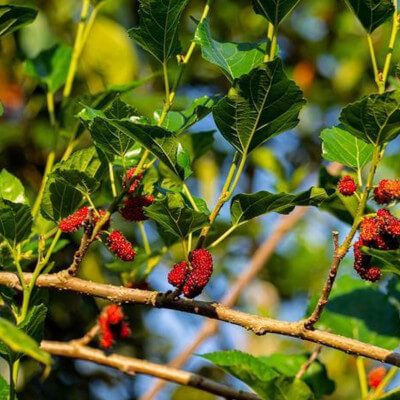
The Morus rubra, commonly known as the Red Mulberry, is a remarkable tree native to North America. Valued for its delicious fruit and dense foliage, it brings both charm and practical benefits to gardens and landscapes. This tree, which can grow between 10 and 15 metres tall, is easily recognised by its large, heart-shaped leaves and its reddish-purple berries that resemble blackberries. Thanks to its striking appearance and unique features, it holds a prominent place in the Au Bois Vert Botanical Garden in Ivato, near Antananarivo.
The Red Mulberry thrives best in fertile, well-drained soils with plenty of sunlight. Its vigorous growth and resilience make it an ideal species for temperate to subtropical climates. Within the Au Bois Vert garden, it serves not only as a decorative element but also supports the local ecosystem by providing shelter and nourishment for a variety of animals, particularly birds.
The Red Mulberry blooms in spring, producing small, inconspicuous greenish flowers. These eventually give way to edible fruits which, when ripe, are appreciated not only for their sweet flavour but also for their nutritional value. Beyond its attractive appearance and tasty berries, this tree also plays a vital ecological role by helping to prevent soil erosion with its strong root system.
Visitors to the Au Bois Vert Botanical Garden have the opportunity to admire this iconic tree while learning about its many uses. Whether appreciated for its ornamental appeal or its delectable fruit, the Morus rubra adds depth to the visitor experience and enhances the unique charm of this site, located close to the hotels, restaurants, and lodges of Ivato.
Plant use
The Morus rubra, or red mulberry, offers a wide range of uses, both culinary and ecological. Its sweet, slightly tangy fruits are often enjoyed fresh or processed. In the kitchen, they are used to make jams, juices, jellies, and even artisanal wines. These homemade products are particularly appreciated in restaurants and hotels, where they enhance the local menus. Beyond their appealing taste, red mulberries boast impressive nutritional qualities. They are rich in vitamin C, iron, and antioxidants, making them a valuable dietary supplement. Additionally, the leaves of Morus rubra contain beneficial compounds used in certain traditional medicines for their anti-inflammatory and antidiabetic properties. The tree also plays an important ecological role. As well as providing food for a variety of birds and small mammals, its deep root system helps stabilise the soil—a valuable trait in areas prone to erosion. In environments like the Au Bois Vert botanical garden, the red mulberry contributes to the preservation of local biodiversity while adding visual appeal. Although its wood is not widely harvested, it is used in the crafting of handmade objects and simple tools. Moreover, its dense canopy offers natural shade, making it ideal for creating relaxing areas in lodges or gardens. In Ivato, this tree is often included in landscaping projects for its natural charm and low maintenance requirements. Thanks to its many benefits, the Morus rubra remains an essential addition to any space devoted to nature, sustainability, and beauty.
Key information
| Common name | Red Mulberry |
| Scientific name | Morus rubra |
| Origin | North America |
| Natural habitat | Temperate rainforests |
| Life cycle | Perennial |
| Flowering period | Spring |


